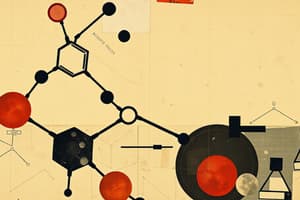Podcast
Questions and Answers
Which spectroscopic technique is most useful for determining the presence of a carbonyl group in an unknown organic compound?
Which spectroscopic technique is most useful for determining the presence of a carbonyl group in an unknown organic compound?
- ¹³C NMR
- ¹H NMR
- Mass Spectrometry
- Infrared (IR) Spectroscopy (correct)
What is the expected major product when 2-methyl-2-butene reacts with HBr?
What is the expected major product when 2-methyl-2-butene reacts with HBr?
- 2-bromo-2-methylbutane (correct)
- 3-bromo-2-methylbutane
- 2-bromo-3-methylbutane
- 1-bromo-2-methylbutane
Which reagent is best suited for converting an alkene to a syn-diol?
Which reagent is best suited for converting an alkene to a syn-diol?
- mCPBA
- H₂ with Pd/C
- OsO₄ (correct)
- KMnO₄, NaOH, cold
What type of intermediate is formed during the epoxidation of an alkene with a peroxyacid?
What type of intermediate is formed during the epoxidation of an alkene with a peroxyacid?
Which of the following reagents is used in the Simmons-Smith reaction?
Which of the following reagents is used in the Simmons-Smith reaction?
Which of the following best describes the product of ozonolysis of an alkene followed by treatment with a reducing agent such as dimethyl sulfide ($DMS$)?
Which of the following best describes the product of ozonolysis of an alkene followed by treatment with a reducing agent such as dimethyl sulfide ($DMS$)?
What is the product of the reaction of 1-butyne with $H_2$ and Lindlar's catalyst?
What is the product of the reaction of 1-butyne with $H_2$ and Lindlar's catalyst?
Which of the following reagents will convert an internal alkyne to a trans-alkene?
Which of the following reagents will convert an internal alkyne to a trans-alkene?
What type of reaction is the conversion of an alkyne to a ketone using $H_2O, H_2SO_4, HgSO_4$?
What type of reaction is the conversion of an alkyne to a ketone using $H_2O, H_2SO_4, HgSO_4$?
Which of the following reagents can be used to deprotonate a terminal alkyne?
Which of the following reagents can be used to deprotonate a terminal alkyne?
What is the product of the reaction of 1-hexyne with ozone ($O_3$) followed by dimethyl sulfide ($DMS$)?
What is the product of the reaction of 1-hexyne with ozone ($O_3$) followed by dimethyl sulfide ($DMS$)?
Which of the following is the strongest nucleophile in a polar protic solvent?
Which of the following is the strongest nucleophile in a polar protic solvent?
Which of the following is a polar aprotic solvent?
Which of the following is a polar aprotic solvent?
Which of the following is the best leaving group?
Which of the following is the best leaving group?
What is the rate-determining step in an $S_N2$ reaction?
What is the rate-determining step in an $S_N2$ reaction?
Which of the following substrates will react fastest in an $S_N2$ reaction?
Which of the following substrates will react fastest in an $S_N2$ reaction?
What is the stereochemical outcome of an $S_N2$ reaction at a chiral center?
What is the stereochemical outcome of an $S_N2$ reaction at a chiral center?
Which factor primarily influences the rate of an $S_N2$ reaction?
Which factor primarily influences the rate of an $S_N2$ reaction?
Consider a multistep synthesis. What is the first step in devising a synthesis for a target molecule?
Consider a multistep synthesis. What is the first step in devising a synthesis for a target molecule?
Which of the following is the most important consideration when proposing steps in a multistep synthesis?
Which of the following is the most important consideration when proposing steps in a multistep synthesis?
Flashcards
Alkene Halogenation
Alkene Halogenation
Adding a halogen (like Cl₂ or Br₂) to an alkene.
Halohydrin Formation
Halohydrin Formation
A reaction where a halogen and a hydroxyl group (-OH) are added to an alkene.
Hydroboration-Oxidation
Hydroboration-Oxidation
A two-step process that converts an alkene into an alcohol via syn addition.
Oxymercuration-Demercuration
Oxymercuration-Demercuration
Signup and view all the flashcards
Alkene Hydration
Alkene Hydration
Signup and view all the flashcards
Alkene Hydrogenation
Alkene Hydrogenation
Signup and view all the flashcards
Epoxide
Epoxide
Signup and view all the flashcards
Alkene Ozonolysis
Alkene Ozonolysis
Signup and view all the flashcards
KMnO₄ Oxidation
KMnO₄ Oxidation
Signup and view all the flashcards
Cyclopropanation
Cyclopropanation
Signup and view all the flashcards
Simmons-Smith Reaction
Simmons-Smith Reaction
Signup and view all the flashcards
Alkyne Hydrohalogenation
Alkyne Hydrohalogenation
Signup and view all the flashcards
Alkyne Halogenation
Alkyne Halogenation
Signup and view all the flashcards
Alkyne Hydration (Acid Catalyzed)
Alkyne Hydration (Acid Catalyzed)
Signup and view all the flashcards
Lindlar's Catalyst
Lindlar's Catalyst
Signup and view all the flashcards
Dissolving Metal Reduction
Dissolving Metal Reduction
Signup and view all the flashcards
Alkyne Ozonolysis
Alkyne Ozonolysis
Signup and view all the flashcards
Substitution Reaction
Substitution Reaction
Signup and view all the flashcards
Polar protic solvent
Polar protic solvent
Signup and view all the flashcards
Polar aprotic solvent
Polar aprotic solvent
Signup and view all the flashcards
Study Notes
- The exam covers all of chapter 8, all of chapter 9, and selected topics from chapter 10.
Chapters 4-6
- Interpret mass, infrared, ¹H NMR, and ¹³C NMR spectra to determine the molecular formula and structure of unknown compounds.
Chapter 8: Electrophilic Addition Reactions of Alkenes
- Recognize, understand, describe, and predict products, reactants, and conditions.
- Understand regiochemistry and stereochemistry.
- Write mechanisms for electrophilic addition reactions of alkenes, including:
- Halogenation
- Halohydrin Formation
- Hydroboration Oxidation
- Mechanism for Step 2 is not required
- Oxymercuration Oxidation
- Mechanism for Step 2 is not required
- Hydration
- Hydrogenation
- No mechanism required
- Epoxidation
- Ring-opening of an epoxide
- Syn-dihydroxylation using OsO₄
- No mechanism required
- Ozonolysis
- No mechanism required
- Potassium permanganate oxidation
- No mechanism required
- Periodic acid oxidation
- No mechanism required
- Carbene synthesis
- No mechanism required
- Cyclopropanation using a carbene
- Simmons-Smith cyclopropanation
- No mechanism required
Chapter 9: Terminal Alkynes
- Describe the relative acidity of terminal alkynes.
- Propose acid-base reactions where a terminal alkyne acts as an acid.
- Recognize, understand, describe, and predict products, reactants, and conditions.
- Reactions include regiochemistry and stereochemistry.
- Write mechanisms for electrophilic addition reactions of alkenes, including:
- Hydrohalogenation
- Halogenation
- Acid-catalyzed hydration and mercury-catalyzed hydration
- No mechanism required
- Keto-enol and aldo-enol tautomerization
- Base mechanism not required; acid is required
- Hydroboration-oxidation
- No mechanism required
- Catalytic hydrogenation
- No mechanism required
- Reduction using a poisoned catalyst (Lindlar’s catalyst)
- No mechanism required
- Dissolving metal reduction
- No mechanism required
- Ozonolysis
- No mechanism required
- Potassium permanganate oxidation
- No mechanism required
- Alkylation of a terminal alkyne
- Synthesis of an alkyne from dihalide
- No mechanism required
Chapter 10: Substitution Reactions
- Define substitution reactions.
- Distinguish between good and bad leaving groups.
- Differentiate between polar protic and polar aprotic solvents.
- Differentiate between strong bases, weak bases, strong nucleophiles, and weak nucleophiles.
- Describe the details of an S№2 reaction including:
- Rate equation
- Mechanism
- Energy diagram
- Transition state
- Substrate effects
- Leaving group effects
- Nucleophile effects
- Solvent effects
- Stereochemical outcome
Chapters 8-10: Multistep Synthesis
- Propose the starting material for a multistep synthesis of a target molecule.
- Propose the product of a multistep synthesis.
- Propose the steps and/or intermediates of a multistep synthesis.
Studying That Suits You
Use AI to generate personalized quizzes and flashcards to suit your learning preferences.




